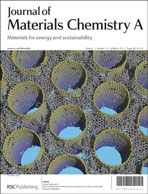Förster resonance energy transfer and carbon dots enhance light harvesting in a solid-state quantum dot solar cell†
Abstract
A novel yet inexpensive quantum dot solar cell (QDSC) configuration relying on Förster resonance energy transfer (FRET) from electrode bound excited cadmium sulfide (CdS) quantum dots ensconced in zinc sulfide (ZnS) monolayers to unattached copper phthalocyanine (CuPc) molecules, dissolved in a free standing sulfide ion based gel polymeric electrolyte, is presented. Luminescent and conducting carbon dots (C-dots) are incorporated in the anode to improve the electron transfer and transport characteristics of the photoactive assembly. Fluorescence quenching and lifetime measurements provide unambiguous proof of dominant energy and not electron transfer from the blue/green absorbing ZnS/CdS/ZnS donor QDs to the red absorbing CuPc acceptor molecules. The subsequent charge transfer rate from CuPc to the current collector via C-dots in the ZnS/CdS/ZnS/C-dot/CuPc assembly is faster and the electron recombination lifetime (with the oxidized species in the electrolyte, τ) is longer, in contrast with the slower rate and shorter τ in the assembly devoid of C-dots, thus confirming the role of C-dots in facilitating charge propagation. The Förster radius calculated from the overlap integral and the actual separation estimated from high resolution transmission electron microscopy between the CdS and CuPc are close, and the energy transfer efficiency is deduced to be 40%. Incident photon to current conversion efficiency (IPCE) measurements revealed an optimal coverage of the visible spectrum for the cells with both donors and acceptors: the ZnS/CdS/ZnS/C-dot/CuPc assembly shows a 5.76 times increment of photocurrent in the blue/green region in comparison with cells with only donor (ZnS/CdS/ZnS). The demonstration of a quasi solid-state FRET enabled cell not only opens up avenues to use photoactive moieties that do not undergo charge transfer as dictated by conventional energy level offsets, but also shows the viability of producing laminated, cheap QDSCs capable of harvesting broader regions of the visible spectrum.


 Please wait while we load your content...
Please wait while we load your content...